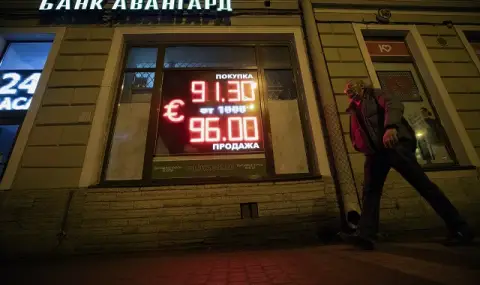So far, Russia's economy has successfully coped with Western sanctions and the costs of the war in Ukraine. Russians' incomes have even increased. But economic growth is slowing down, and inflation is rising. What does this lead to?
Contrary to the expectations of the authorities and experts, in 2024 the Russian economy showed extremely high growth rates. The preliminary data is for GDP growth of 3.5 to 4 percent, but this growth is already slowing: 5.4 percent in the first quarter, 4.1 percent in the second and 3.1 percent in the third. The government's GDP growth forecast for 2025 is 2.5%, and the Central Bank predicts even lower figures - between 0.1 and 1.5 percent.
Russia's economy has successfully overcome crises thanks to tried-and-tested manual management mechanisms, but they still restrain development even in periods of relative stability, says economist Alexandra Prokopenko. The constant expectation of new shocks has taught the authorities to focus on accumulating reserves, sacrificing investment. The same approach is applied by private companies, which limits their willingness to take risks, expansion and long-term investments.
The military industry is growing, but not the civilian industry
A key feature of the post-war recovery growth will be the fact that it is concentrated in a limited number of economic sectors that are related either to military needs or to adaptation to international sanctions. At the same time, many civilian sectors have never recovered from the crisis.
For example, in November 2024, car production was 20 percent lower than in November 2019, according to data from the Center for Macroeconomic Analysis, which is close to the Russian government. The decline in woodworking was more than 10%, and in the extraction of minerals, which is the largest sector in the Russian economy, the decrease was 6%.
The leaders in growth are the so-called “other means of transport“ (which also includes military equipment), metal products (weapons and ammunition), as well as electronics and optics - necessary for both. These goods have seen a doubling of production compared to 2019.
The militarization of the economy creates imbalances
In order to significantly increase weapons production, the government has invested enormous amounts of money in the military-industrial sector. In 2025, direct defense and security spending alone will exceed 5% of GDP. This is 40% of federal budget spending - the state has not spent so much since Soviet times.
Defense companies had to increase the number of employees - and they began to lure them from other sectors of the economy, offering them higher salaries. They, in turn, were forced to act in the same way - and a spiral began in the wage sector. It was further strengthened by the fact that the Russian labor market lost hundreds of thousands of workers due to large-scale emigration, mobilization and recruitment of contract soldiers.
From January to September 2024, according to official statistics, the average salary in Russia increased by 9%, the nominal one - by 18%. The dynamics of GDP and wages created the illusion of the Russian economy's resilience to war and sanctions. But this illusion will begin to dissipate in 2025.
The risks of unbalanced economic growth
The growth in the incomes of workers, as well as military personnel and their family members, fueled inflation. It could reach 10 percent in 2024. People are willing to spend their increased incomes, but Russian industry is focused on producing goods that ordinary people do not use. If the situation were normal, this problem would be solved by imports - but imports are limited due to sanctions.
To curb inflation, the Central Bank of Russia raised the key interest rate to 21%, and the increase in commercial banks is even greater. Thus, consumption was reduced, but at the same time, the possibilities for lending, i.e. for business development, were limited.
Defense enterprises do not have this problem, because the interest rates on their loans are subsidized by the government. And the Central Bank intends to keep interest rates high for a long time. It follows that economic activity will increasingly be concentrated in the military and related sectors of the economy, which continue to drain resources from all others. But the military-industrial complex can no longer grow at the previous pace - according to various estimates, its capacities are already almost completely exhausted.
Is Stagflation Coming and What Dangers Does It Pose for Russia?
The stagnation of the economy in the face of high inflation is a well-known phenomenon called stagflation. It was first encountered by the economies of the United States and other Western countries in the mid-1970s and then in the 1980s. In the first case, stagflation was caused by a sharp rise in oil prices, in the second - by the fact that central banks printed a lot of hard money.
The insidiousness of stagflation is that it is difficult to get out of it. Raising interest rates in conditions of stagflation deepens the stagnation. At the same time, stimulating the economy by reducing interest rates only fuels inflation.
The Russian authorities are aware of the risks of stagflation. And the recipe they offer is to return the economy to the “trajectory of balanced growth“, i.e. to stop stimulating the military economic sectors at the expense of civilian ones. However, in wartime, this is impossible, and in peacetime, it is not guaranteed. The government's budget projects for 2026 and 2027 do not foresee any cuts in military spending.
